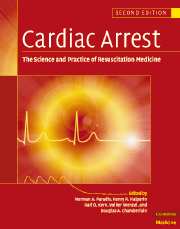Book contents
- Frontmatter
- Contents
- List of contributors
- Foreword
- Preface
- Part I Introduction
- Part II Basic science
- Part III The pathophysiology of global ischemia and reperfusion
- Part IV Therapy of sudden death
- 23 Prevention of sudden cardiac death
- 24 Sequence of therapies during resuscitation: application of CPR
- 25 Transthoracic defibrillation
- 26 Automated external defibrillators
- 27 Public access defibrillation
- 28 The physiology of ventilation during cardiac arrest and other low blood flow states
- 29 Airway techniques and airway devices
- 30 Manual cardiopulmonary resuscitation techniques
- 31 Mechanical devices for cardiopulmonary resuscitation
- 32 Invasive reperfusion techniques
- 33 Routes of drug administration
- 34 Adrenergic agonists
- 35 Vasopressin and other non-adrenergic vasopressors
- 36 Antiarrhythmic therapy during cardiac arrest and resuscitation
- 37 Acid–base considerations and buffer therapy
- 38 Cardiac arrest resuscitation monitoring
- 39 Special considerations in the therapy of non-fibrillatory cardiac arrest
- 40 Cardiocerebral resuscitation: a new approach to out-of-hospital cardiac arrest
- 41 Thrombolysis during resuscitation from cardiac arrest
- 42 Percutaneous coronary intervention (PCI) after successful reestablishment of spontaneous circulation and during cardiopulmonary resuscitation
- 43 Emergency medical services systems and out-of-hospital cardiac arrest
- 44 In-hospital resuscitation
- 45 Complications of CPR
- 46 Bringing it all together: state-of-the-art therapy for cardiac arrest
- Part V Postresuscitation disease and its care
- Part VI Special resuscitation circumstances
- Part VII Special issues in resuscitation
- Index
30 - Manual cardiopulmonary resuscitation techniques
from Part IV - Therapy of sudden death
Published online by Cambridge University Press: 06 January 2010
- Frontmatter
- Contents
- List of contributors
- Foreword
- Preface
- Part I Introduction
- Part II Basic science
- Part III The pathophysiology of global ischemia and reperfusion
- Part IV Therapy of sudden death
- 23 Prevention of sudden cardiac death
- 24 Sequence of therapies during resuscitation: application of CPR
- 25 Transthoracic defibrillation
- 26 Automated external defibrillators
- 27 Public access defibrillation
- 28 The physiology of ventilation during cardiac arrest and other low blood flow states
- 29 Airway techniques and airway devices
- 30 Manual cardiopulmonary resuscitation techniques
- 31 Mechanical devices for cardiopulmonary resuscitation
- 32 Invasive reperfusion techniques
- 33 Routes of drug administration
- 34 Adrenergic agonists
- 35 Vasopressin and other non-adrenergic vasopressors
- 36 Antiarrhythmic therapy during cardiac arrest and resuscitation
- 37 Acid–base considerations and buffer therapy
- 38 Cardiac arrest resuscitation monitoring
- 39 Special considerations in the therapy of non-fibrillatory cardiac arrest
- 40 Cardiocerebral resuscitation: a new approach to out-of-hospital cardiac arrest
- 41 Thrombolysis during resuscitation from cardiac arrest
- 42 Percutaneous coronary intervention (PCI) after successful reestablishment of spontaneous circulation and during cardiopulmonary resuscitation
- 43 Emergency medical services systems and out-of-hospital cardiac arrest
- 44 In-hospital resuscitation
- 45 Complications of CPR
- 46 Bringing it all together: state-of-the-art therapy for cardiac arrest
- Part V Postresuscitation disease and its care
- Part VI Special resuscitation circumstances
- Part VII Special issues in resuscitation
- Index
Summary
The standard technique of external chest compression in cardiopulmonary resuscitation (CPR) has changed little since the landmark paper of Kouwenhoven et al. in 1960 (Fig. 30.1). This is despite the fact that a variety of alternate techniques have been proposed as providing an advantage over the standard method. The rhythmic application of force to the body of the patient is fundamental to the process of generating blood flow in CPR, but there is little agreement as to the optimal technique for applying that force. There is a great need for improved external chest compression techniques since only an average of 15% of patients treated with standard CPR survive cardiac arrest, and it is widely agreed that increasing the blood flow generated by chest compression will improve survival.
This chapter will review the standard external chest compression technique as it is currently taught, including its origins and its rather scant scientific basis. It will also explore in detail the origins, physiology, and applicability of some alternate manual techniques that have been proposed.
Standard external chest compression
According to the most recently published guidelines of the Emergency Cardiac Care Committee of the American Heart Association, external chest compressions are applied by the rescuer who places the heel of one hand over the victim's sternum. The second hand is placed on top of the first in such a way that the fingers do not touch the chest. The fingers may be interlocked if desired. Force is applied straight down with the elbows locked and the shoulders in line with the hands.
- Type
- Chapter
- Information
- Cardiac ArrestThe Science and Practice of Resuscitation Medicine, pp. 571 - 584Publisher: Cambridge University PressPrint publication year: 2007
- 1
- Cited by

